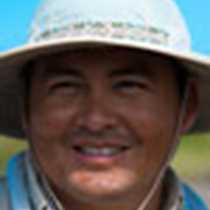Isabela and Fernandina Island
Whales, dolphins, penguins, sea turtles, and flock of birds…oh my!!! Early risers joined us in the skydeck to help us to search for marine mammals early in the morning while we where sailing along the northern coast of Isabela Island. Our effort paid off a few minutes later, a pod of common dolphins were spotted on the horizon. Our natural quest continues since our goal was to find whales. Twenty minutes later another pod of unidentified dolphins showed up; sudenly, without expecting what was coming next the glassy ocean surface was dirupted by a couple of Cuvier’s beaked whales (Ziphius cavirostris), which are very rare to see in the Galápagos. We continued our navigation along the coast of Isabela, which offers a bizarre volcanic landscape, until we reached our final destination for our morning outing.
The morning daytrip started with a Zodiac ride along the coastline of Ecuador Volcano; there we enjoyed the playful and graceful Galápagos fur sea lions that were swimming around our Zodiacs. In addition, we found different species of shore birds such as brown noddies, blue-footed boobies, and brown pelicans. Although the water temperature was around 70¢ªF it was not cold enough to keep us away from the water to enjoy the underwater realm. The snorkeling activities took place from the Zodiacs; firsthand we observed dozens of green Pacific sea turtles that were foraging on green algae, Galápagos penguins, flightless cormorants, and a variety of tropical fish. While we were having a Peruvian style lunch, we were underway to our next destination Fernandina Island.
Fernandina Island is the third largest and youngest island in Galápagos. The island is an active shield volcano that erupted in April 2009. In the afternoon everybody was enthusiastic because we were visiting one of the largest most pristine islands in the world. As expected hundreds of marine iguanas, the only sea going lizards in the world, were basking on pahoehoe lava flows while others were still feeding on algae in the cold waters of Canal Bolivar. Along the trail we also found Flightless cormorants that just came back ashore from fishing. Moreover, an unexpected sighting of a Galápagos racer astonished us. Sea lions and sea turtles were sighted in the tidal pools that are formed by the change of tides. Our afternoon trip finished having a better understanding of how natural selection works in the Galápagos Islands. We had a splendid end with a great sunset.




